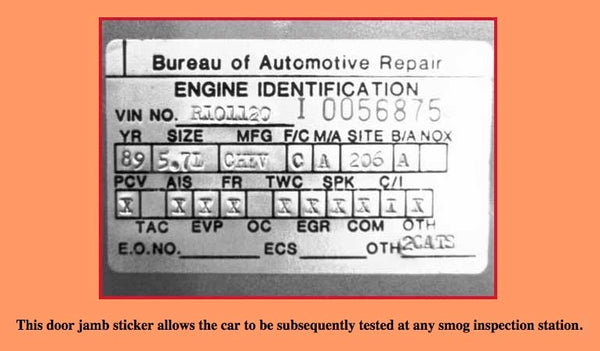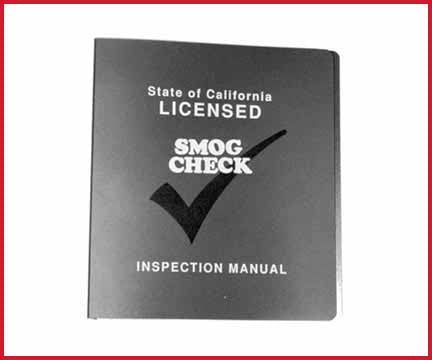Don't Worry, They Aren't that Bad: CALIFORNIA SMOG LAWS
DONT WORRY, THEY AREN'T THAT BAD!
Due to some misinformation, and exaggeration; people across the country think the California style smog laws are the end of engine swaps. Even in California, many automotive enthusiasts believe it is against the law to perform engine swaps.
The basic intent of the California engine change laws is that when you do an engine swap, the new engine/transmission cannot pollute more than the original engine/transmission. This means the newly installed engine must be the same year (or newer) as the vehicle, and all emissions controls on the newly installed engine must be installed and functional. Also, you can't put a heavy-duty truck engine (over 6000 lb GVW) into an S-10 Truck because heavy-duty truck engines have less stringent emissions limits than light-duty trucks.
To get your engine swap approved, you must go to a Referee Station. The Referee Inspection is less than $40, and it is a benefit for people who do smog-legal engine changes because the engine change can be approved on a visual inspection, current smog laws, and common sense.
The Referee Station will visually inspect the vehicle and engine/transmission for all the proper smog equipment, and inspect the engine to be sure it is the same year (or newer) as the vehicle. If all is there, they will put an "Engine Identification"tag in the door jamb. The "Engine Identification"tag is not mentioned on any registration papers or ownership papers. It is only on the vehicle.
If your vehicle does not pass the visual inspection, and you feel it should, you can have the Referee Inspector call the engineering office for a ruling. If the engineering office fails your vehicle and you think it should pass, you can always run it through the California Air Resources Board (CARB) for a full Federal Test Procedure (FTD), but that can cost you several thousand dollars, and your vehicle may still fail. Remember, the Referee Inspection program is a benefit for people who do engine swaps.
The California smog laws on engine swaps (or engine changes) are consistent with common sense, safety, and emissions reduction.
The EPA recognizes California smog laws as being applicable across the nation. That is, if it is legal in California, then according to the EPA, it is legal in all other states. While some states do not yet necessarily agree with this, it is likely that most states will come around to the California way. Other states with pollution problems will likely be adopting the California smog laws because there has been a tremendous amount of time and money invested in making the California smog laws reasonable, consistent, and effective for pollution reduction. It is far cheaper for other state governments to adopt the California laws rather than come up with their own laws. When the smog laws are consistent across the nation, there will be far less confusion for all involved.
THE INSPECTION PROCEDURE
Let's assume you have done a California smog-legal engine change to your vehicle. You have installed an engine that is the same year (or newer) as your vehicle, with all of the required smog equipment and controls for both the engine and transmission. The chassis has the correct emissions controls: Catalytic converter, charcoal canister, and fuel filler restrictor (if required). Your next step is to visit a "referee station."
The DMV (Department of Motor Vehicles) can get you the phone number required to make an appointment with the referee station. When you call to make the appointment, the person on the phone will ask you why you need to go to the referee station. Your answer will be, "Engine change."If you say, "Engine swap"or "V8 conversion,"the person on the phone may not know what you are talking about, so please, just say "engine change."
Next, the person will ask for your name, address, and the vehicle's license number. You will then get an appointment date, which can range anywhere from the very next day, to five weeks away. Some areas have appointments on Saturdays if that is more convenient for you. Within a few days, you will receive a postcard in the mail confirming your appointment date, and it will tell you to bring the vehicle's registration papers and any other smog-related paperwork that you may have.
When you arrive at the referee station, be polite, be honest, and be patient. The inspectors rarely see engine swaps. They usually see stock vehicles that have failed the smog inspection. The inspectors are a lot like police officers—they are highly trained, and the public only sees them when there is a problem. Remember, it is their job to make sure your vehicle is smog legal. For all they know, you could be an undercover inspector, so don't expect the inspector to let anything slide, because his job may be at stake.
The inspectors have a general training in smog inspection, and will not necessarily be an expert on the type of engine in your car. They see Volkswagens, Fords, Volkswagens, Chryslers, Volkswagens, Datsuns, Volkswagens, Toyotas, Volkswagens, Mercedes, Volkswagens, Chevrolets, and Volkswagens—just about everything ever built, so they cannot be expected to be an expert on every vehicle's smog equipment, unless of course it's a Volkswagen.
The inspection takes anywhere from 30 minutes to over one hour, depending on the inspector and the type of "engine change."Some inspectors will want to be left alone with your vehicle, others may ask for your assistance in locating devices such as the charcoal canister, vehicle speed sensor, or the wiring for the lock-up torque converter. The inspector will check ignition timing and EGR operation.
If your vehicle passes the visual inspection, a sticker will be placed in the door jamb or engine compartment (see next page).
If your vehicle does not pass the visual inspection, you will be given a form explaining what your vehicle will need to pass the inspection. You will need to correct the problem(s) listed on the form and make another appointment with the referee station.
After the visual inspection, the vehicle will be given the tailpipe (or sniffer) test. The tailpipe test is quite lenient. If your vehicle cannot pass the tailpipe test, something is wrong, or your engine has been modified a lot. Generally, a vehicle's tail pipe emissions will be about 1/3 of the allowable standards if it is running decently.
If your vehicle passes the visual inspection and the tail pipe test, you will get the smog inspection certificate ($7 fee) so that you can register your vehicle. The certificate has no indication of the "engine change,"and is the same type of certificate that "normal" vehicles receive for passing the inspection.
We at JTR really do believe in running clean cars. We are located in a high smog area and we see (and smell) the smog in the air almost every day. Now that we have the technology to make cars perform well and run clean, lets make an effort to keep OUR air clean.
The sticker in the door jamb (below) allows the car to be subsequently tested at any smog inspection station. It gives the following information on what smog equipment the vehicle requires.

Explanation of Sticker Contents:
| VIN No. |
Serial number of the vehicle |
TAC | Thermostatic Air Cleaner | |
| YR. | Year of the engine (not the vehicle) | AIS | Air Injection System | |
| SIZE | Engine size | EVP | Evaporative Controls (charcoal canister) | |
| MFG | Manufacturer of the engine | FR | Fuel Filler Restrictor (unleaded gas) | |
| F/C | Federal/California smog requirements | OC | Oxidizing Catalytic Converter | |
| M/A | Manual/Automatic transmission | TWC | Three-Way Catalytic Converter | |
| SITE | Where the car was inspected | EGR | Exhaust Gas Recirculation | |
| B/A | Before/After. If the engine was installed before March of 1984, it may not need any smog controls | SPK | Spark (distributor) controls | |
| COM | Computer | |||
| NOX | NOx Emission Controls | C/I | Carburetor/Injection | |
| PCV | Positive Crankcase Ventilation | OTH | Other smog controls |

BUY THE BOOK
For the best information on smog laws in California, go to your local Bureau of Automotive Repair (BAR) office, and purchase the Smog Check Inspection Manual. To find one near you, look in the phone book in the "State Government Offices" section, under "Automotive Repair Bureau". This book is filled with valuable information, and it has important phone numbers should you have any questions about your swap. Cost of the book is less than $20.
